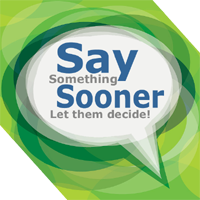REDUCE 9-1-1
DELAYS

This 5 Minute Task
Could Save Your Life!
9-1-1 Recommends

Call Sooner
Let Them Decide
In doubt, not sure? Call 9-1-1. Never be afraid to dial 9-1-1 because of uncertainty. Whether a medical issue, a fire, or a situation concerns you, call now, not later. First responders say not calling soon enough delays help for the medical condition making it more acute when you finally call.
Better than anyone else, they understand what IS and IS NOT an emergency. Let them decide!
Do If you accidentally call 9-1-1 please stay on the line and tell the call taker that you do not have an emergency. Otherwise, they may send help.
Do Pull over when driving, if possible. This reduces the chance of a dropped call.
Do Lock your keypad when not in use, so 9-1-1 isnt dialed by mistake.
Always 9-1-1 from a cell phone is always free. The area code is not necessary.
Do Not Put 9-1-1 on speed dial.
Do Not
Give old phones
to children as toys. A wireless phone,
with no active service, can still call 9-1-1.
Expect (Who - What - Why - When & Where)
Where? The location should be the first thing you disclose to the operator. If for any reason contact with communications is lost, the location is known.
Tips: Make sure to include apartment number, lot number, or any other information such as the name of the apartment or business when giving your location. If you do not know where you are, look for a mailbox, street sign, or any type of landmark that can give the operator an indication of where you may be.
What? The operator needs to know the nature of the incident, so the appropriate agency can respond. The Operator may ask for your telephone number, description of person or vehicle involved, if any.
Tips: Be specific to the operator of what exactly is going on. Let them know if you need police, fire, or an ambulance. Description of vehicle; color, year, make, model, body style, any other descriptors, and the license tag. Description of person; race, sex, hair/eye color, height, clothing description (head to toe, inside/out).
When? The operator needs to know if the incident is occurring at the present time or if it has already taken place. This is very important to the agencies responding.
Tips: Give the operator an approximate time frame of when the incident occurred.
Who? Law enforcement needs to know who they need to speak with when arriving on scene and names of people involved in the incident.
Tips: Callers can remain anonymous if requested. If you know the parties involved, please give their first and last name if known.
Weapons? If weapons are involved, the operator needs to know immediately. This information is vitally important for the safety of the officer and/or emergency personnel responding to the scene.
On the average, every individual in the U.S. or Canada will call for emergency assistance at least twice during their lifetime.
Watch
How to Reduce 9-1-1 Delays!
Documents to Reduce 9-1-1 Delays
The information,
documents and downloads on this website are open source and free to download
and use for your organization. Under no circumstance are they to be sold or
used to make a profit. All Rights Reserved - Lee Hite
Reduce 9-1-1
Delays (Checklist)
Items for
the 9-1-1 Premise Page
Emergency Medical Data
Sheet English
9-1-1 Addressing That Works
Emergency Medical Data
Sheet Spanish
Emergency Shut-Off Signage
Emergency Medical Data
(Long Form English)
Healthy Hydrants Guideline
Emergency Medical Data
(Example)
It's Okay to ASK
Alternate Key Holder
Registration
Sirens & Lights Guidelines
Alternate Key Holder
Information
Family Records Retention
Forms
Become a Helpful Responder Not a Helpless
Bystander